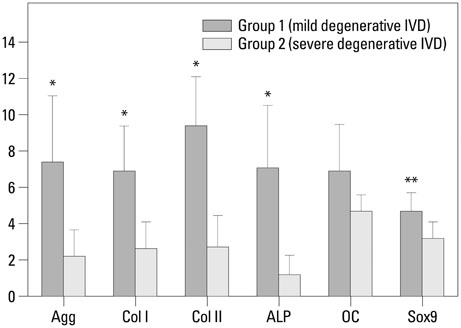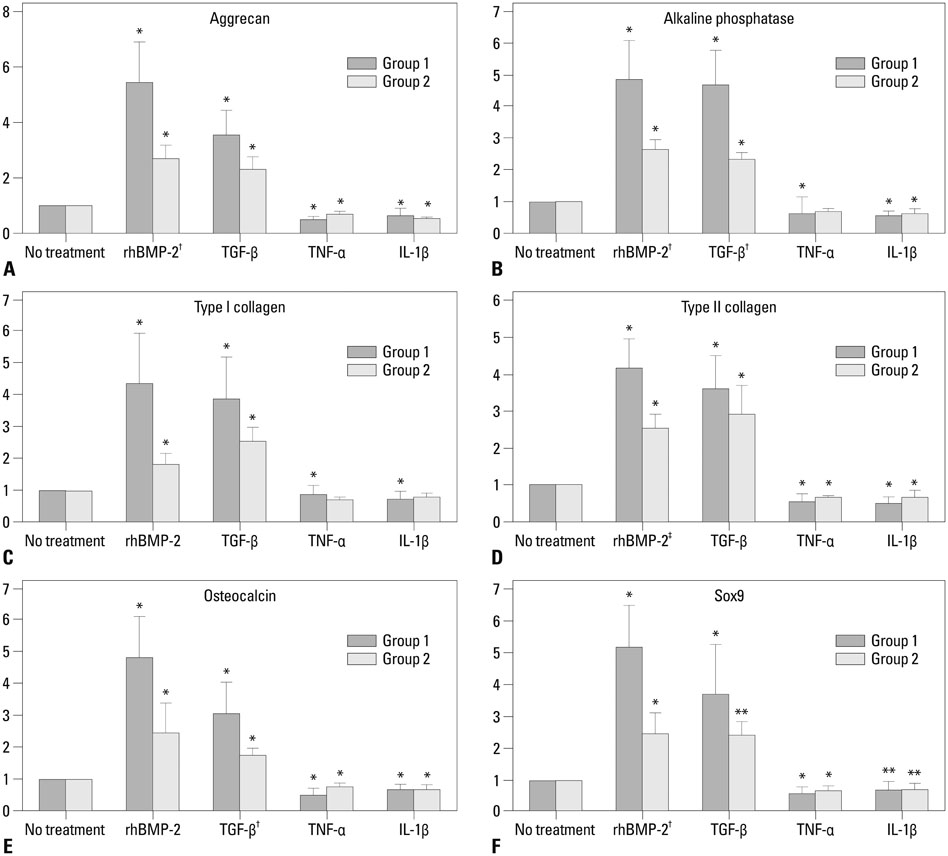Yonsei Med J.
2015 Jan;56(1):277-286. 10.3349/ymj.2015.56.1.277.
Biologic Response of Degenerative Living Human Nucleus Pulposus Cells to Treatment with Cytokines
- Affiliations
-
- 1Department of Neurosurgery, Ajou University College of Medicine, Suwon, Korea.
- 2Department of Neurosurgery, The Spine and Spinal Cord Institute, Gangnam Severance Hospital, Yonsei University College of Medicine, Seoul, Korea. kuhsu@yuhs.ac
- KMID: 2352817
- DOI: http://doi.org/10.3349/ymj.2015.56.1.277
Abstract
- PURPOSE
To investigate the molecular responses of various genes and proteins related to disc degeneration upon treatment with cytokines that affect disc-cell proliferation and phenotype in living human intervertebral discs (IVDs). Responsiveness to these cytokines according to the degree of disc degeneration was also evaluated.
MATERIALS AND METHODS
The disc specimens were classified into two groups: group 1 (6 patients) showed mild degeneration of IVDs and group 2 (6 patients) exhibited severe degeneration of IVDs. Gene expression was analyzed after treatment with four cytokines: recombinant human bone morphogenic protein (rhBMP-2), transforming growth factor-beta (TGF-beta), interleukin-1beta (IL-1beta), and tumor necrosis factor-alpha (TNF-alpha). Molecular responses were assessed after exposure of cells from the IVD specimens to these cytokines via real-time polymerase chain reaction and immunofluorescence staining.
RESULTS
mRNA gene expression was significantly greater for aggrecan, type I collagen, type II collagen, alkaline phosphatase, osteocalcin, and Sox9 in group 1 than mRNA gene expression in group 2, when the samples were not treated with cytokines. Analysis of mRNA levels for these molecules after morphogen treatment revealed significant increases in both groups, which were much higher in group 1 than in group 2. The average number of IVD cells that were immunofluorescence stained positive for alkaline phosphatase increased after treatment with rhBMP-2 and TGF-beta in group 1.
CONCLUSION
The biologic responsiveness to treatment of rhBMP-2, TGF-beta, TNF-alpha, and IL-1beta in the degenerative living human IVD can be different according to the degree of degeneration of the IVD.
MeSH Terms
-
Adult
Aggrecans/genetics/metabolism
Alkaline Phosphatase/genetics/metabolism
Biological Products/pharmacology/*therapeutic use
Bone Morphogenetic Protein 2/pharmacology/therapeutic use
Collagen Type I/genetics/metabolism
Collagen Type II/genetics/metabolism
Cytokines/*pharmacology/*therapeutic use
Female
Fluorescent Antibody Technique
Gene Expression Regulation/drug effects
Humans
Interleukin-1/pharmacology/therapeutic use
Intervertebral Disc/*drug effects/*pathology
Intervertebral Disc Degeneration/*drug therapy/genetics/*pathology
Male
Middle Aged
Osteocalcin/genetics/metabolism
RNA, Messenger/genetics/metabolism
Recombinant Proteins/pharmacology/therapeutic use
SOX9 Transcription Factor/genetics/metabolism
Transforming Growth Factor beta/pharmacology/therapeutic use
Tumor Necrosis Factor-alpha/pharmacology
Alkaline Phosphatase
Aggrecans
Biological Products
Bone Morphogenetic Protein 2
Collagen Type I
Collagen Type II
Cytokines
Interleukin-1
Osteocalcin
RNA, Messenger
Recombinant Proteins
SOX9 Transcription Factor
Transforming Growth Factor beta
Tumor Necrosis Factor-alpha
Figure
Reference
-
1. Deyo RA, Tsui-Wu YJ. Descriptive epidemiology of low-back pain and its related medical care in the United States. Spine (Phila Pa 1976). 1987; 12:264–268.
Article2. Buckwalter JA. Aging and degeneration of the human intervertebral disc. Spine (Phila Pa 1976). 1995; 20:1307–1314.
Article3. Shvartzman L, Weingarten E, Sherry H, Levin S, Persaud A. Cost-effectiveness analysis of extended conservative therapy versus surgical intervention in the management of herniated lumbar intervertebral disc. Spine (Phila Pa 1976). 1992; 17:176–182.
Article4. Antoniou J, Demers CN, Beaudoin G, Goswami T, Mwale F, Aebi M, et al. Apparent diffusion coefficient of intervertebral discs related to matrix composition and integrity. Magn Reson Imaging. 2004; 22:963–972.
Article5. Antoniou J, Steffen T, Nelson F, Winterbottom N, Hollander AP, Poole RA, et al. The human lumbar intervertebral disc: evidence for changes in the biosynthesis and denaturation of the extracellular matrix with growth, maturation, ageing, and degeneration. J Clin Invest. 1996; 98:996–1003.
Article6. Pritzker KP. Aging and degeneration in the lumbar intervertebral disc. Orthop Clin North Am. 1977; 8:66–77.
Article7. Takegami K, Thonar EJ, An HS, Kamada H, Masuda K. Osteogenic protein-1 enhances matrix replenishment by intervertebral disc cells previously exposed to interleukin-1. Spine (Phila Pa 1976). 2002; 27:1318–1325.
Article8. An HS, Takegami K, Kamada H, Nguyen CM, Thonar EJ, Singh K, et al. Intradiscal administration of osteogenic protein-1 increases intervertebral disc height and proteoglycan content in the nucleus pulposus in normal adolescent rabbits. Spine (Phila Pa 1976). 2005; 30:25–31.
Article9. Takegami K, An HS, Kumano F, Chiba K, Thonar EJ, Singh K, et al. Osteogenic protein-1 is most effective in stimulating nucleus pulposus and annulus fibrosus cells to repair their matrix after chondroitinase ABC-induced in vitro chemonucleolysis. Spine J. 2005; 5:231–238.
Article10. Sakai D, Mochida J, Yamamoto Y, Nomura T, Okuma M, Nishimura K, et al. Transplantation of mesenchymal stem cells embedded in Atelocollagen gel to the intervertebral disc: a potential therapeutic model for disc degeneration. Biomaterials. 2003; 24:3531–3541.
Article11. Watanabe K, Mochida J, Nomura T, Okuma M, Sakabe K, Seiki K. Effect of reinsertion of activated nucleus pulposus on disc degeneration: an experimental study on various types of collagen in degenerative discs. Connect Tissue Res. 2003; 44:104–108.
Article12. Matsunaga S, Nagano S, Onishi T, Morimoto N, Suzuki S, Komiya S. Age-related changes in expression of transforming growth factor-beta and receptors in cells of intervertebral discs. J Neurosurg. 2003; 98:1 Suppl. 63–67.
Article13. Okuda S, Myoui A, Ariga K, Nakase T, Yonenobu K, Yoshikawa H. Mechanisms of age-related decline in insulin-like growth factor-I dependent proteoglycan synthesis in rat intervertebral disc cells. Spine (Phila Pa 1976). 2001; 26:2421–2426.
Article14. Osada R, Ohshima H, Ishihara H, Yudoh K, Sakai K, Matsui H, et al. Autocrine/paracrine mechanism of insulin-like growth factor-1 secretion, and the effect of insulin-like growth factor-1 on proteoglycan synthesis in bovine intervertebral discs. J Orthop Res. 1996; 14:690–699.
Article15. Gruber HE, Hanley EN Jr. Biologic strategies for the therapy of intervertebral disc degeneration. Expert Opin Biol Ther. 2003; 3:1209–1214.
Article16. Brisby H, Tao H, Ma DD, Diwan AD. Cell therapy for disc degeneration--potentials and pitfalls. Orthop Clin North Am. 2004; 35:85–93.
Article17. Handa T, Ishihara H, Ohshima H, Osada R, Tsuji H, Obata K. Effects of hydrostatic pressure on matrix synthesis and matrix metalloproteinase production in the human lumbar intervertebral disc. Spine (Phila Pa 1976). 1997; 22:1085–1091.
Article18. Martinek V, Ueblacker P, Imhoff AB. Current concepts of gene therapy and cartilage repair. J Bone Joint Surg Br. 2003; 85:782–788.
Article19. Nishida K, Doita M, Takada T, Shimomura T, Maeno K, Kakutani K, et al. [Biological approach for treatment of degenerative disc diseases]. Clin Calcium. 2005; 15:79–86.20. Alini M, Roughley PJ, Antoniou J, Stoll T, Aebi M. A biological approach to treating disc degeneration: not for today, but maybe for tomorrow. Eur Spine J. 2002; 11:Suppl 2. S215–S220.
Article21. Sato M, Asazuma T, Ishihara M, Ishihara M, Kikuchi T, Kikuchi M, et al. An experimental study of the regeneration of the intervertebral disc with an allograft of cultured annulus fibrosus cells using a tissue-engineering method. Spine (Phila Pa 1976). 2003; 28:548–553.
Article22. Luk KD, Ruan DK, Chow DH, Leong JC. Intervertebral disc autografting in a bipedal animal model. Clin Orthop Relat Res. 1997; 13–26.
Article23. Pfeiffer M, Boudriot U, Pfeiffer D, Ishaque N, Goetz W, Wilke A. Intradiscal application of hyaluronic acid in the non-human primate lumbar spine: radiological results. Eur Spine J. 2003; 12:76–83.
Article24. Roberts S, Caterson B, Menage J, Evans EH, Jaffray DC, Eisenstein SM. Matrix metalloproteinases and aggrecanase: their role in disorders of the human intervertebral disc. Spine (Phila Pa 1976). 2000; 25:3005–3013.25. Guiot BH, Fessler RG. Molecular biology of degenerative disc disease. Neurosurgery. 2000; 47:1034–1040.
Article26. Hoyland JA, Le Maitre C, Freemont AJ. Investigation of the role of IL-1 and TNF in matrix degradation in the intervertebral disc. Rheumatology (Oxford). 2008; 47:809–814.
Article27. Lipson SJ, Muir H. 1980 Volvo award in basic science Proteoglycans in experimental intervertebral disc degeneration. Spine (Phila Pa 1976). 1981; 6:194–210.28. Pearce RH, Grimmer BJ, Adams ME. Degeneration and the chemical composition of the human lumbar intervertebral disc. J Orthop Res. 1987; 5:198–205.
Article29. Boos N, Weissbach S, Rohrbach H, Weiler C, Spratt KF, Nerlich AG. Classification of age-related changes in lumbar intervertebral discs: 2002 Volvo Award in basic science. Spine (Phila Pa 1976). 2002; 27:2631–2644.30. Roughley PJ. Biology of intervertebral disc aging and degeneration: involvement of the extracellular matrix. Spine (Phila Pa 1976). 2004; 29:2691–2699.31. Oegema TR Jr. The role of disc cell heterogeneity in determining disc biochemistry: a speculation. Biochem Soc Trans. 2002; 30(Pt 6):839–844.
Article32. Thompson JP, Oegema TR Jr, Bradford DS. Stimulation of mature canine intervertebral disc by growth factors. Spine (Phila Pa 1976). 1991; 16:253–260.
Article33. Kim DJ, Moon SH, Kim H, Kwon UH, Park MS, Han KJ, et al. Bone morphogenetic protein-2 facilitates expression of chondrogenic, not osteogenic, phenotype of human intervertebral disc cells. Spine (Phila Pa 1976). 2003; 28:2679–2684.
Article34. Park JS, Nagata K. [BMP and LMP-1 for intervertebral disc regeneration]. Clin Calcium. 2004; 14:76–78.35. Kuh SU, Zhu Y, Li J, Tsai KJ, Fei Q, Hutton WC, et al. A comparison of three cell types as potential candidates for intervertebral disc therapy: annulus fibrosus cells, chondrocytes, and bone marrow derived cells. Joint Bone Spine. 2009; 76:70–74.
Article36. Diefenderfer DL, Brighton CT. Microvascular pericytes express aggrecan message which is regulated by BMP-2. Biochem Biophys Res Commun. 2000; 269:172–178.
Article37. Fassett DR, Kurd MF, Vaccaro AR. Biologic solutions for degenerative disk disease. J Spinal Disord Tech. 2009; 22:297–308.
Article38. Adam M, Deyl Z. Degenerated annulus fibrosus of the intervertebral disc contains collagen type II. Ann Rheum Dis. 1984; 43:258–263.
Article39. Kim KS, Yoon ST, Park JS, Li J, Park MS, Hutton WC. Inhibition of proteoglycan and type II collagen synthesis of disc nucleus cells by nicotine. J Neurosurg. 2003; 99:3 Suppl. 291–297.
Article40. Zhao CQ, Wang LM, Jiang LS, Dai LY. The cell biology of intervertebral disc aging and degeneration. Ageing Res Rev. 2007; 6:247–261.
Article41. Séguin CA, Pilliar RM, Roughley PJ, Kandel RA. Tumor necrosis factor-alpha modulates matrix production and catabolism in nucleus pulposus tissue. Spine (Phila Pa 1976). 2005; 30:1940–1948.
Article42. Rutges JP, Kummer JA, Oner FC, Verbout AJ, Castelein RJ, Roestenburg HJ, et al. Increased MMP-2 activity during intervertebral disc degeneration is correlated to MMP-14 levels. J Pathol. 2008; 214:523–530.
Article43. Yoon ST, Patel NM. Molecular therapy of the intervertebral disc. Eur Spine J. 2006; 15:Suppl 3. S379–S388.
Article44. Kuh SU, Zhu Y, Li J, Tsai KJ, Fei Q, Hutton WC, et al. Can TGF-beta1 and rhBMP-2 act in synergy to transform bone marrow stem cells to discogenic-type cells? Acta Neurochir (Wien). 2008; 150:1073–1079.
Article45. Lee S, Moon CS, Sul D, Lee J, Bae M, Hong Y, et al. Comparison of growth factor and cytokine expression in patients with degenerated disc disease and herniated nucleus pulposus. Clin Biochem. 2009; 42:1504–1511.
Article46. Li J, Yoon ST, Hutton WC. Effect of bone morphogenetic protein-2 (BMP-2) on matrix production, other BMPs, and BMP receptors in rat intervertebral disc cells. J Spinal Disord Tech. 2004; 17:423–428.
Article
- Full Text Links
- Actions
-
Cited
- CITED
-
- Close
- Share
- Similar articles
-
- Role of Tumor Necrosis Factor Alpha, Interleukin 8 and Dexamethasone in the FAK Expression by Human Nucleus Pulposus Cells
- MRI Study about the Early Changes of Lumbar Disk Degeneration using Magnetization Transfer Contrast (MTC)
- Current Concepts of Degenerative Disc Disease -A Significance of Endplate-
- Regression of Herniated Nucleus Pulposus after Anterior Interbody Fusion
- Photoelastic analysis of the Stress distribution on an intervertebral disc





